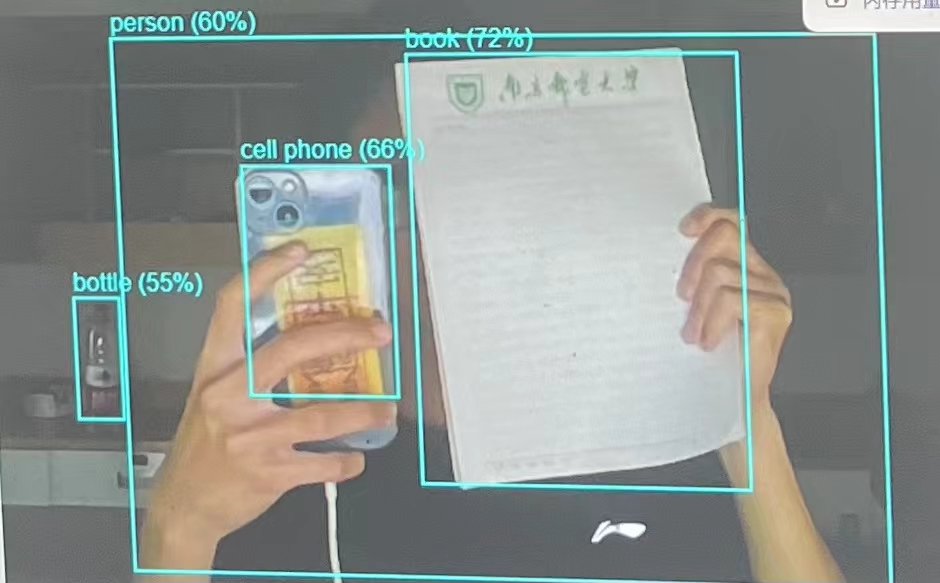阅读量:0


基于TensorFlow.js和COCO-SsD模型的实时目标检测网络应用程序
实现流程
- 访问用户的桌面录屏并且显示视频源(位置居中)。
- 对视频源进行实时目标检测。
- 在检测到的目标周围绘制边界框,并用它们的类别和检测置信度进行标记。
- 在视频源下方显示一个唯一检测到的目标列表,显示目标类别和首次检测到的时间。
- 确保每个目标类别只列出一次,不管它被检测到多少次。
- 使用2帧每秒的检测频率来平衡性能和响应性。
- 包括屏幕录制访问和模型加载的错误处理。
- 为应用程序设计一个干净、现代的外观,并具有响应式设计。
- 将所有必要的HTML、CSS和JavaScriptt包含在一个单一的自包含文件中。
- 为TensorFlow.js和COCO-SSD模型库使用CDN链接。 请提供完整可运行的HTML文件,其中包含内联CSS和JavaScript。
效果图

代码
<!DOCTYPE html> <html lang="zh-CN"> <head> <meta charset="UTF-8"> <meta name="viewport" content="width=device-width, initial-scale=1.0"> <title>实时目标检测</title> <script src="https://cdn.jsdelivr.net/npm/@tensorflow/tfjs"></script> <script src="https://cdn.jsdelivr.net/npm/@tensorflow-models/coco-ssd"></script> <style> body { font-family: Arial, sans-serif; display: flex; flex-direction: column; align-items: center; background-color: #f0f0f0; margin: 0; padding: 20px; } h1 { color: #333; } #videoContainer { position: relative; margin-bottom: 20px; } #output { position: absolute; top: 0; left: 0; } #detectionsList { background-color: white; border-radius: 8px; padding: 20px; box-shadow: 0 4px 6px rgba(0, 0, 0, 0.1); max-width: 600px; width: 100%; } #detectionsList h2 { margin-top: 0; } #detectionsList ul { list-style-type: none; padding: 0; } #detectionsList li { margin-bottom: 10px; padding: 10px; background-color: #f9f9f9; border-radius: 4px; } #error { color: red; margin-top: 20px; } </style> </head> <body> <h1>实时目标检测</h1> <div id="videoContainer"> <video id="video" width="640" height="480" autoplay muted></video> <canvas id="output" width="640" height="480"></canvas> </div> <div id="detectionsList"> <h2>检测到的目标</h2> <ul id="detectedObjects"></ul> </div> <div id="error"></div> <script> const video = document.getElementById('video'); const output = document.getElementById('output'); const ctx = output.getContext('2d'); const detectedObjects = document.getElementById('detectedObjects'); const errorDiv = document.getElementById('error'); let model; let detections = new Map(); async function setupCamera() { try { const stream = await navigator.mediaDevices.getDisplayMedia({ video: true }); video.srcObject = stream; return new Promise((resolve) => { video.onloadedmetadata = () => { resolve(video); }; }); } catch (error) { errorDiv.textContent = '无法访问屏幕录制:' + error.message; throw error; } } async function loadModel() { try { model = await cocoSsd.load(); } catch (error) { errorDiv.textContent = '无法加载模型:' + error.message; throw error; } } async function detectObjects() { try { const predictions = await model.detect(video); ctx.clearRect(0, 0, ctx.canvas.width, ctx.canvas.height); ctx.drawImage(video, 0, 0, ctx.canvas.width, ctx.canvas.height); predictions.forEach(prediction => { const [x, y, width, height] = prediction.bbox; ctx.strokeStyle = '#00FFFF'; ctx.lineWidth = 2; ctx.strokeRect(x, y, width, height); ctx.fillStyle = '#00FFFF'; ctx.font = '16px Arial'; ctx.fillText(`${prediction.class} (${Math.round(prediction.score * 100)}%)`, x, y > 10 ? y - 5 : 10); if (!detections.has(prediction.class)) { const timestamp = new Date().toLocaleTimeString(); detections.set(prediction.class, timestamp); updateDetectionsList(); } }); } catch (error) { console.error('检测对象时出错:', error); } setTimeout(detectObjects, 500); // 每2秒检测一次 (2 FPS) } function updateDetectionsList() { detectedObjects.innerHTML = ''; detections.forEach((timestamp, objectClass) => { const li = document.createElement('li'); li.textContent = `${objectClass} - 首次检测时间: ${timestamp}`; detectedObjects.appendChild(li); }); } async function run() { try { await setupCamera(); await loadModel(); detectObjects(); } catch (error) { console.error('应用程序初始化失败:', error); } } run(); </script> </body> </html> 
